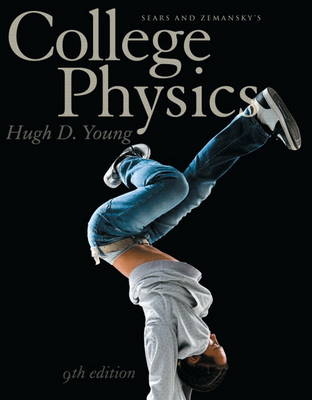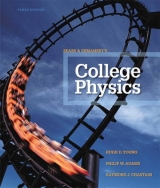
College Physics Plus Mastering Physics with eText -- Access Card Package
Addison-Wesley Educational Publishers Inc
978-0-321-74980-2 (ISBN)
- Titel erscheint in neuer Auflage
- Artikel merken
For more than five decades, Sears and Zemansky's College Physics has provided the most reliable foundation of physics education for readers around the world. The Ninth Edition continues that tradition with new features that directly address the demands on today's reader and today's classroom.
A broad and thorough introduction to physics, this new edition maintains its highly respected, traditional approach while implementing some new solutions to student difficulties. Many ideas stemming from educational research help students develop greater confidence in solving problems, deepen conceptual understanding, and strengthen quantitative-reasoning skills, while helping them connect what they learn with their other courses and the changing world around them. Math review has been expanded to encompass a full chapter, complete with end-of-chapter questions, and in each chapter biomedical applications and problems have been added along with a set of MCAT-style passage problems. Media resources have been strengthened and linked to the Pearson eText, MasteringPhysics (R), and much more.
This packge contains:
College Physics, Ninth Edition
MasteringPhysics with Pearson eText Student Access Code Card
Key Topics:
Mathematics Review, Models, Measurements, and Vectors, Motion along a Straight Line, Motion in a Plane, Newton's Laws of Motion, Applications of Newton's Laws, Circular Motion and Gravitation, Work and Energy, Momentum, Rotational Motion,
Dynamics of Rotational Motion, Elasticity and Periodic Motion, Fluid Mechanics, Temperature and Heat, Thermal Properties of Matter, The Second Law of Thermodynamics, Electric Charge and Electric Field, Electric Potential and Capacitance, Magnetic Field and Magnetic Forces, Electromagnetic Induction, Alternating Current, Geometric Optics, Optical Instruments, Interference and Diffraction, Relativity, Photons, Electrons, and Atoms, Atoms, Molecules, and Solids, Nuclear and High-Energy Physics
Market Description: Intended for those who are interested in gaining a basic knowledge of general physics
Hugh D. Young is Emeritus Professor of Physics at Carnegie Mellon University. He earned both his undergraduate and graduate degrees from that university. He earned his Ph.D. in fundamental particle theory under the direction of the late Richard Cutkosky. He also had two visiting professorships at the University of California, Berkeley. Dr. Young's career has centered entirely on undergraduate education. He has written several undergraduate-level textbooks, and became a coauthor with Francis Sears and Mark Zemansky for their well-known introductory texts. In addition to his role on Sears and Zemansky's College Physics, he is also author of Sears and Zemansky's University Physics.
Chapter 0 Mathematics Review
0.1 Exponents
0.2 Scientific Notation and Powers of 10
0.3 Algebra
0.4 Direct, Inverse, and Inverse-Square Relationships
0.5 Logarithmic and Exponential Functions
0.6 Areas and Volumes
0.7 Plane Geometry and Trigonometry
Chapter 1 Models, Measurements, and Vectors
1.1 Introduction
1.2 Idealized Models
1.3 Standards and Units
1.4 Unit Consistency and Conversions
1.5 Precision and Significant Figures
1.6 Estimates and Orders of Magnitude
1.7 Vectors and Vector Addition
1.8 Components of Vectors
Chapter 2 Motion along a Straight Line
2.1 Displacement and Average Velocity
2.2 Instantaneous Velocity
2.3 Average and Instantaneous Acceleration
2.4 Motion with Constant Acceleration
2.5 Proportional Reasoning
2.6 Freely Falling Objects
2.7 Relative Velocity along a Straight Line
Chapter 3 Motion in a Plane
3.1 Velocity in a Plane
3.2 Acceleration in a Plane
3.3 Projectile Motion
3.4 Uniform Circular Motion
3.5 Relative Velocity in a Plane
Chapter 4 Newton's Laws of Motion
4.1 Force
4.2 Newton's First Law
4.3 Mass and Newton's Second Law
4.4 Mass and Weight
4.5 Newton's Third Law
4.6 Free-Body Diagrams
Chapter 5 Applications of Newton's Laws
5.1 Equilibrium of a Particle
5.2 Applications of Newton's Second Law
5.3 Contact Forces and Friction
5.4 Elastic Forces
5.5 Forces in Nature
Chapter 6 Circular Motion and Gravitation
6.1 Force in Circular Motion
6.2 Motion in a Vertical Circle
6.3 Newton's Law of Gravitation
6.4 Weight
6.5 Satellite Motion
Chapter 7 Work and Energy
7.1 An Overview of Energy
7.2 Work
7.3 Work and Kinetic Energy
7.4 Work Done by a Varying Force
7.5 Potential Energy
7.6 Conservation of Energy
7.7 Conservative and Nonconservative Forces
7.8 Power
Chapter 8 Momentum
8.1 Momentum
8.2 Conservation of Momentum
8.3 Inelastic Collisions
8.4 Elastic Collisions
8.5 Impulse
8.6 Center of Mass
8.7 Motion of the Center of Mass
8.8 Rocket Propulsion
Chapter 9 Rotational Motion
9.1 Angular Velocity and Angular Acceleration
9.2 Rotation with Constant Angular Acceleration
9.3 Relationship between Linear and Angular Quantities
9.4 Kinetic Energy of Rotation and Moment of Inertia
9.5 Rotation about a Moving Axis
Chapter 10 Dynamics of Rotational Motion
10.1 Torque
10.2 Torque and Angular Acceleration
10.3 Work and Power in Rotational Motion
10.4 Angular Momentum
10.5 Conservation of Angular Momentum
10.6 Equilibrium of a Rigid Body
10.7 Vector Nature of Angular Quantities
Chapter 11 Elasticity and Periodic Motion
11.1 Stress, Strain, and Elastic Deformations
11.2 Periodic Motion
11.3 Energy in Simple Harmonic Motion
11.4 Equations of Simple Harmonic Motion
11.5 The Simple Pendulum
11.6 Damped and Forced Oscillations
Chapter 12 Mechanical Waves and Sound
12.1 Mechanical Waves
12.2 Periodic Mechanical Waves
12.3 Wave Speeds
12.4 Mathematical Description of a Wave
12.5 Reflections and Superposition
12.6 Standing Waves and Normal Modes
12.7 Longitudinal Standing Waves
12.8 Interference
12.9 Sound and Hearing
12.10 Sound Intensity
12.11 Beats
12.12 The Doppler Effect
12.13 Applications of Acoustics
12.14 Musical Tones
Chapter 13 Fluid Mechanics
13.1 Density
13.2 Pressure in a Fluid
13.3 Archimedes's Principle: Buoyancy
13.4 Surface Tension and Capillarity
13.5 Fluid Flow
13.6 Bernoulli's Equation
13.7 Applications of Bernoulli's equation
13.8 Real Fluids: Viscosity and Turbulence
Chapter 14 Temperature and Heat
14.1 Temperature and Thermal Equilibrium
14.2 Temperature Scales
14.3 Thermal Expansion
14.4 Quantity of Heat
14.5 Phase Changes
14.6 Calorimetry
14.7 Heat Transfer
14.8 Solar Energy and Resource Conservation
Chapter 15 Thermal Properties of Matter
15.1 The Mole and Avogadro's Number
15.2 Equations of State
15.3 Kinetic Theory of an Ideal Gas
15.4 Heat Capacities
15.5 The First Law of Thermodynamics
15.6 Thermodynamic Processes
15.7 Properties of an Ideal Gas
Chapter 16 The Second Law of Thermodynamics
16.1 Directions of Thermodynamic Processes
16.2 Heat Engines
16.3 Internal Combustion Engines
16.4 Refrigerators
16.5 The Second Law of Thermodynamics
16.6 The Carnot Engine: The Most Efficient Heat Engine
16.7 Entropy
16.8 The Kelvin Temperature Scale
16.9 Energy Resources: A Case Study in Thermodynamics
Chapter 17 Electric Charge and Electric Field
17.1 Electric charge
17.2 Conductors and Insulators
17.3 Conservation and Quantization of Charge
17.4 Coulomb's Law
17.5 Electric Field and Electric Forces
17.6 Calculating Electric Fields
17.7 Electric Field Lines
17.8 Gauss's Law and Field Calculations
17.9 Charges on Conductors
Chapter 18 Electric Potential and Capacitance
18.1 Electric Potential Energy
18.2 Potential
18.3 Equipotential Surfaces
18.4 The Millikan Oil-Drop Experiment
18.5 Capacitors
18.6 Capacitors in Series and in Parallel
18.7 Electric Field Energy
18.8 Dielectrics
18.9 Molecular Model of Induced Charge
Chapter 19 Current, Resistance, and Direct-Current Circuits
19.1 Current
19.2 Resistance and Ohm's Law
19.3 Electromotive Force and Circuits
19.4 Energy and Power in Electric Circuits
19.5 Resistors in Series and Parallel
19.6 Kirchhoff's Rules
19.7 Electrical Measuring Instruments
19.8 Resistance-Capacitance Circuits
19.9 Physiological Effects of Currents
19.10 Power Distribution Systems
Chapter 20 Magnetic Field and Magnetic Forces
20.1 Magnetism
20.2 Magnetic Field and Magnetic Force
20.3 Motion of Charged Particles in a Magnetic Field
20.4 Mass Spectrometers
20.5 Magnetic Force on a Current-Carrying Conductor
20.6 Force and Torque on a Current Loop
20.7 Magnetic Field of a Long, Straight Conductor
20.8 Force between Parallel Conductors
20.9 Current Loops and Solenoids
20.10 Magnetic Field Calculations
20.11 Magnetic Materials
Chapter 21 Electromagnetic Induction
21.1 Induction Experiments
21.2 Magnetic Flux
21.3 Faraday's Law
21.4 Lenz's Law
21.5 Motional Electromotive Force
21.6 Eddy Currents
21.7 Mutual Inductance
21.8 Self-Inductance
21.9 Transformers
21.10 Magnetic Field Energy
21.11 The R-L Circuit
21.12 The L-C Circuit
Chapter 22 Alternating Current
22.1 Phasors and Alternating Currents
22.2 Resistance and Reactance
22.3 The Series R-L-C Circuit
22.4 Power in Alternating-Current Circuits
22.5 Series Resonance
22.6 Parallel Resonance
Chapter 23 Electromagnetic Waves
23.1 Introduction to Electromagnetic Waves
23.2 Speed of an Electromagnetic Wave
23.3 The Electromagnetic Spectrum
23.4 Sinusoidal Waves
23.5 Energy in Electromagnetic Waves
23.6 Nature of Light
23.7 Reflection and Refraction
23.8 Total Internal Reflection
23.9 Dispersion
23.10 Polarization
23.11 Huygens's Principle
23.12 Scattering of Light
Chapter 24 Geometric Optics
24.1 Reflection at a Plane Surface
24.2 Reflection at a Spherical Surface
24.3 Graphical Methods for Mirrors
24.4 Refraction at a Spherical Surface
24.5 Thin Lenses
24.6 Graphical Methods for Lenses
Chapter 25 Optical Instruments
25.1 The Camera
25.2 The Projector
25.3 The Eye
25.4 The Magnifier
25.5 The Microscope
25.6 Telescopes
25.7 Lens Aberrations
Chapter 26 Interference and Diffraction
26.1 Interference and Coherent Sources
26.2 Two-Source Interference of Light
26.3 Interference in Thin Films
26.4 Diffraction
26.5 Diffraction from a Single Slit
26.6 Multiple Slits and Diffraction Gratings
26.7 X-Ray Diffraction
26.8 Circular Apertures and Resolving Power
26.9 Holography
Chapter 27 Relativity
27.1 Invariance of Physical Laws
27.2 Relative Nature of Simultaneity
27.3 Relativity of Time
27.4 Relativity of Length
27.5 The Lorentz Transformation
27.6 Relativistic Momentum
27.7 Relativistic Work and Energy
27.8 Relativity and Newtonian Mechanics
Chapter 28 Photons, Electrons, and Atoms
28.1 The Photoelectric Effect
28.2 Line Spectra and Energy Levels
28.3 The Nuclear Atom and the Bohr Model
28.4 The Laser
28.5 X-Ray Production and Scattering
28.6 The Wave Nature of Particles
28.7 Wave-Particle Duality
28.8 The Electron Microscope
Chapter 29 Atoms, Molecules, and Solids
29.1 Electrons in Atoms
29.2 Atomic Structure
29.3 Diatomic Molecules
29.4 Structure and Properties of Solids
29.5 Energy Bands
29.6 Semiconductors
29.7 Semiconductor Devices
29.8 Superconductivity
Chapter 30 Nuclear and High-Energy Physics
30.1 Properties of Nuclei
30.2 Nuclear Stability
30.3 Radioactivity
30.4 Radiation and the Life Sciences
30.5 Nuclear Reactions
30.6 Nuclear Fission
30.7 Nuclear Fusion
30.8 Fundamental Particles
30.9 High-Energy Physics
30.10 Cosmology
| Erscheint lt. Verlag | 10.1.2011 |
|---|---|
| Verlagsort | New Jersey |
| Sprache | englisch |
| Maße | 10 x 10 mm |
| Gewicht | 2330 g |
| Themenwelt | Naturwissenschaften ► Physik / Astronomie |
| ISBN-10 | 0-321-74980-4 / 0321749804 |
| ISBN-13 | 978-0-321-74980-2 / 9780321749802 |
| Zustand | Neuware |
| Haben Sie eine Frage zum Produkt? |
aus dem Bereich



